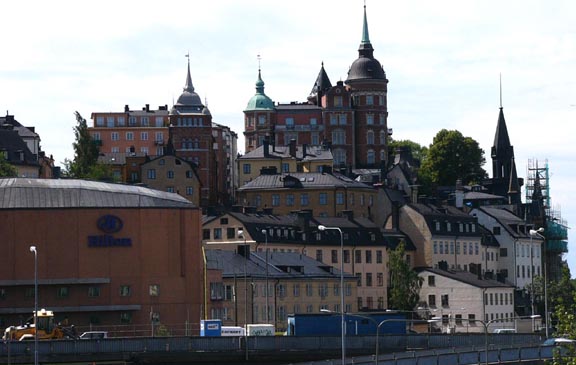|
STOCKHOLM
Our
only stop in Sweden....

We went from Finland to
Stockholm, Sweden's great city, via an overnight ferry that was eleven
stories tall –
kind of an
instant city with a population somewhere between that of Crested Butte
and
Gunnison, four or five restaurants, a bar around every corner,
gambling, a
couple bands playing in different places, and an all-night schedule. It
has a
reputation, apparently, as a party boat – beer is only four euros
(about 6
bucks), other alcohol comparatively cheap, and it is kind of between
jurisdictions. Plus, you’re allowed to buy about all you can
carry tax-free.
Scandinavians pay very high taxes compared to Americans, and since half
of it
isn’t poured into “defense” spending, they get a
great deal for their money.
But fundamentally, they seem to be very American in their attitude
about taxes
– maybe “very human” is what I should say: if they
can get out of paying them,
they will – even though they want all the services, like
single-payer
health care,
that the taxes buy….
The picture above was what we saw coming
into Stockholm. The foreground buildings are part of Gamla Stan, the
old city. As the cranes in the background suggest, there is a new city
too.... But we spent most of our time there in and around the old
city, which has a human scale, like Helsinki, and - in the summer - a
lot of people out and about.
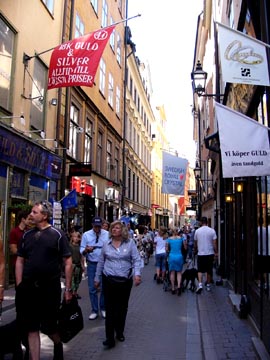

We were struck, in Stockholm as in Helsinki, not just by the fact that
the "old cities" had been so well preserved, but seemed to actually
still be part of (if not the core of) the vitality of the cities. We
were also struck by the amount and quality of "decoration" on the old
buildings.
There is a degree of ornamentation to the
architecture that is functionally useless in structural terms –
indeed, it probably
adds unnecessary weight. Modern buildings – say, post-WW II
– have completely
eschewed this kind of thing, along with the craftsmen who could produce
it.
Unnecessary costs for an era increasingly focused on bumping along on
the
bottom line.
What’s lost is a lot of beauty.
“Why shouldn’t things be
beautiful?” Maryo keeps asking. But I think it’s more than
just beauty – or say
instead: beauty is always something more than just beautiful. A door
that is
wooden, and carved, seems to invite you in (even though it’s
probably locked);
a glass and aluminum door just stares back blankly, shrugs its lack of
concern
about whether you want to come in or not. Some Stockholm doors - and
also an inviting micro-park....
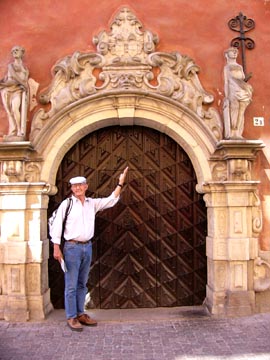  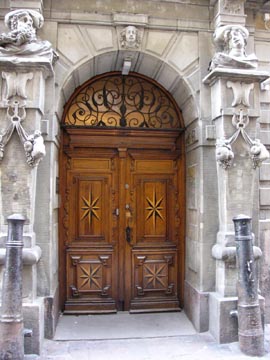

We’ve been to three museums
here that
kind of track the
evolution of human buildings through the three major epochs, or
whatever you
would call them, of human settlement: at the Sami outdoor museum in
Sapmi/Lapland, we saw structures from the long long epoch of people
moving
about in the landscape, sometimes with shelters they carried with them,
sometimes with semi-permanent structures along the route the reindeer
took in
their tidal flow up and down the tundra; then at an outdoor museum in
Helsinki
we saw old farm buildings, originals or moved there or careful
reconstructions,
from the time when population pressures forced people to begin
concentrating
the foods they needed in protectable places; then at the Stadtmuseum
(City
Museum) in Stockholm we saw exhibits about urban architecture and how
it
developed as people overpopulated the farm country and had to move into
ever
denser concentrations.
One thing that all three epochs seem
to have
in common was a
move toward “decoration” – except that the
decorations were not just doodling;
they were signs and symbols that represented stories, inferred
connections with
higher powers, or proclaimed individual and class distinctions. They
were, in
short, about the soul of the place; good structures were important, but
a good
soulful history and relationship with the universe was important too,
and the
decorations, whether the runic abstractions of the Sami or the
coat-of-armsish
abstractions over or on Stockholm doors, told something of the soul of
the
place.
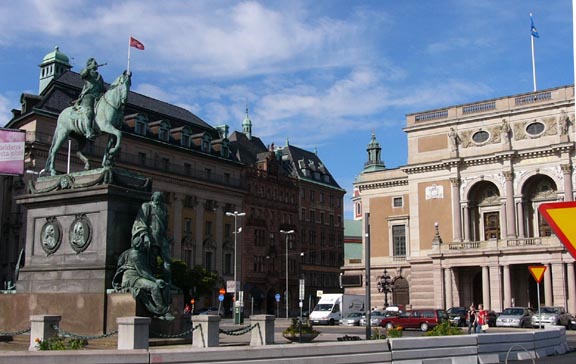
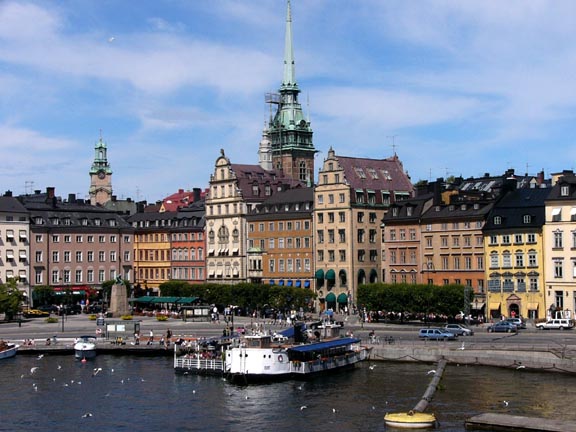
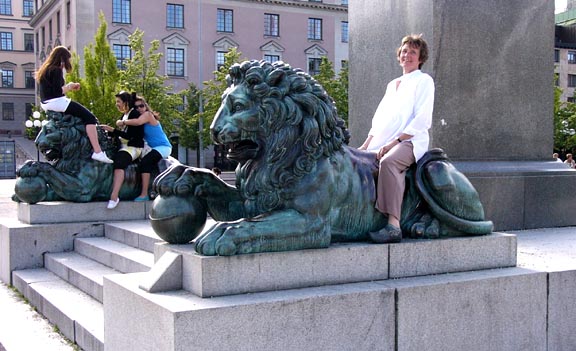
"What's with all
the lion?" Maryo asked. Everywhere we went there
seemed to be statues of lions. Another set of stories, probably,
involving the time when Sweden was more imperial. Sweden still has a
king; the king still has a palace; and the palace of course has to be
guarded. We followed a crowd one day to the midday "Changing of the
Guard" at the palace, a process they manage to stretch out to about 45
minutes of pomp and circumstance, with a band and everything. We were
part of a crowd of close to 1,000. Here are some pictures of that, and
the palace....
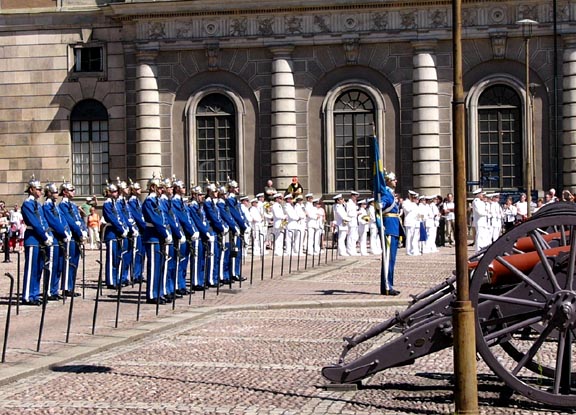

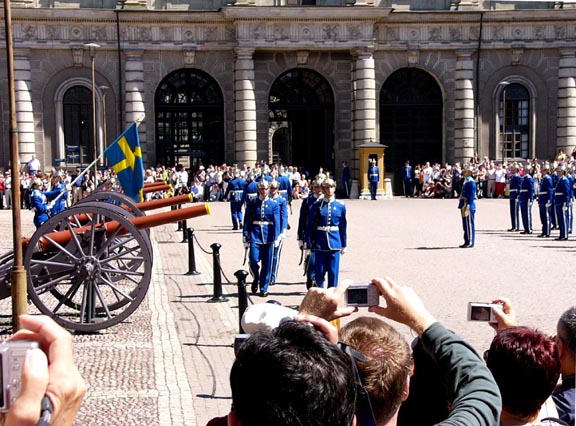
Later, in the more
relaxed and lovely "King's Park," we found a promenade lined with
artist and artisan booths on one side, and cafes and restaurants on the
other, with outdoor tables for watching the passing parade. It was also
lined with strange signs apparently collected from all over the
world....
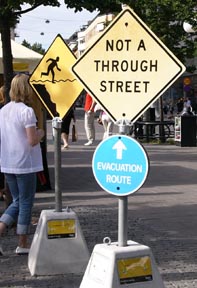
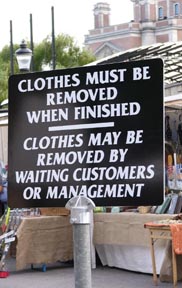
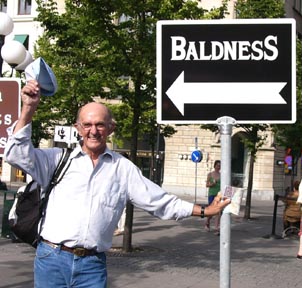

We also went to a “Wine and Spirits
Museum” that I guess
also tells something of the soul of the cities. People have always been
experimenting with “mind expanders,” through all three of
those “epochs,” and
wandering around that museum – almost unfindable on the fourth
floor of an old
brick building (largely undecorated) that used to be a storehouse for
imported
wines – we found ourselves wondering why this seems to be such a
human
characteristic. Why do we want to get a buzz on? Or occasionally just
get plain
drunk? What are we looking for?
We learned at the Wine and Spirits
Museum
that people began
to get serious about alcohol – not just fermenting the grapes and
grains and
honey they found, but starting to distill it into the powerful stuff
– about
the same time that we started congregating in cities: around 6,000
years ago,
in the Asia Minor region from which all the Indo-European languages
spread and
diversified. This might go along with my evolving theory about the need
for
evolution of the brain; cultural evolution has moved a lot faster than
physical
evolution, and our brain is probably still wired for the
hunter-gatherer life
where we have spent 99.9 percent of our time evolving as a species.
Does
alcohol really help us move off the open spaces of the steppe and
tundra and
into the intensity of the city?
One exhibit in the Wine and Spirits
Museum
discussed the relationship between vodka and work, and the working
class – which at various
times in
Swedish history was partially paid in vodka (just eliminate the
middleman). The
Swedish government tried various strategies to deal with the alcohol
issue. For
a time, they just said the hell with reform and took over the entire
importing
and distribution process; there was a lot of money to be made in
selling
spirits and they decided they might as well be taking in that money.
But more
often, there were efforts to keep the working class from destroying
itself with
vodka. Laws like the “two dram rules” and “not a dram
without buying food too”
mostly made the working class rebellious and were rescinded; the fact
is,
alcohol – a steady fog of being high or hungover – may have
been the only thing
making working-class life bearable in the “paleotechnic”
era of industrial
development. At the Stadtmuseum we’d seen the mean (largely
undecorated) living
quarters of the working poor, where waste disposal was still primitive
with
“shitladies” collecting what they could of the human
product, diet was poor,
and hope was (so said the Church) for the next life, not this one.
That is one side of alcohol and its
role in
the unfolding
evolving human experience. The two-drink high
makes all
things seem possible – and of course suggests that even more
might be possible
with a third or fifth drink…. Then you wake up.
But if we have to have cities, let them be like Stockholm and
Helsinki....
|

















